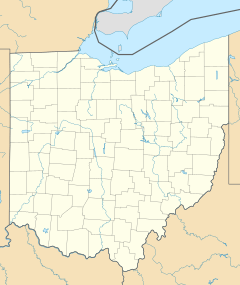Singer Lake Bog facts for kids
Quick facts for kids Singer Lake Bog |
|
|---|---|
| Location | Summit County, Ohio |
| Nearest city | Green |
| Area | 344 acres (139 ha) |
| Governing body | The Cleveland Museum of Natural History |
Singer Lake Bog is a special nature preserve in Ohio, a state in the United States. It covers a large area of 344 acres, which is about the size of 260 football fields! This amazing place is owned and protected by the Cleveland Museum of Natural History.
What makes Singer Lake Bog so unique is its huge leatherleaf bog, which is over fifty acres big. This is the largest of its kind in all of Ohio. Inside the preserve, there's also a five-acre kettle lake bog. A kettle lake is a shallow lake formed by melting glaciers long ago. This bog is home to many interesting plants like tamarack trees, poison sumac, tasty cranberries, and even special meat-eating plants like the northern purple pitcher plant and round-leaved sundew. You can also find sphagnum moss here, which is a type of moss that helps form bogs.
This natural wonder is located in the southern part of Summit County, close to the city of Green, Ohio. It's a great place to learn about unique ecosystems and the plants and animals that live there.
Contents
Unique Plants of Singer Lake Bog
Singer Lake Bog is famous for its unusual plants. It is home to two types of carnivorous plants. These are plants that get some of their food by trapping and eating insects. They do this because the soil in bogs often doesn't have enough nutrients.
The Northern Purple Pitcher Plant
The northern purple pitcher plant (Sarracenia purpurea) has leaves shaped like pitchers or cups. These pitchers collect rainwater. Insects are attracted to the plant's colors and nectar. When they fall into the pitcher, they can't climb out because of slippery walls and downward-pointing hairs. The plant then digests the insects to get the nutrients it needs.
The Round-Leaved Sundew
The round-leaved sundew (Drosera rotundifolia) is another fascinating carnivorous plant found here. Its leaves are covered with tiny, sticky hairs that look like dewdrops. When an insect lands on these sticky hairs, it gets stuck. The plant then slowly wraps its leaf around the insect to digest it. It's like a tiny, living flytrap!
Other Important Plants
Besides the carnivorous plants, the bog also has many other interesting plants. You can find leatherleaf shrubs, which are common in bogs. There are also tamarack trees, which are unusual because they are conifers that lose their needles in the fall. And, of course, there are wild cranberries growing in the wet, acidic soil. Sphagnum moss is also very important here. It acts like a giant sponge, holding a lot of water and making the bog's soil very acidic.
Animals Living at Singer Lake Bog
The bog's unique environment also supports various animals. These creatures have adapted to live in this wet and wild place.
Mammals of the Bog
You might spot some busy beavers at Singer Lake Bog. Beavers are known for building dams and lodges in watery areas. Their activities can even change the landscape of the bog. Squirrels are also common here. They are often seen scampering up trees and looking for food. Sometimes, people have seen wild domestic cats in the area. These cats might be strays or pets that have wandered away from nearby homes.


